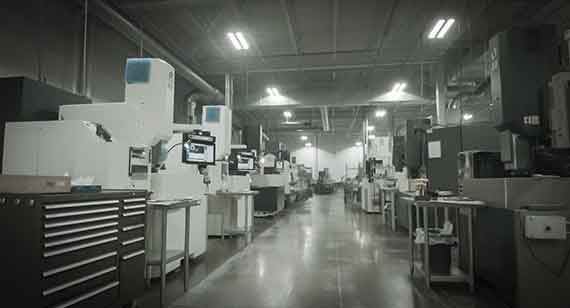What is Electrical Discharge Machining (EDM)?
Most injection molding tools we fabricate through our standard machining process, but there are instances where a geometry requires the use of electrical discharge machining or EDM.
What are the Types of Electrical Discharge Machining (EDM)?
EDM is a subtractive manufacturing method that uses electrical discharges to machine features on a mold. There are two distinct varieties of EDM, die-sink and wire cutting.
At China Metal Parts, we use die-sink EDM machines, which can also be referred to as cavity-type EDM, ram EDM, volume EDM, sinking, burning, spark machining, or spark eroding. Die-sink EDM removes material from the workpiece—the mold in this case—with a graphite electrode, dielectric fluid, and electric current to create a spark discharge. The spark discharge erodes the workpiece to form the final geometry.

Why Use Electrical Discharge Machining?
Given that our molding process is centered on speed, EDM is only used in circumstances where design compromises can’t be made. Most often this means parts with sharp corners on contoured surfaces, or sharp V-shape features, that otherwise can’t be formed using our high-speed milling process. Examples of sharp features include: energy directors, gear teeth, crush ribs, or piercing features. We also use EDM to fabricate steel molds for high temperature resins like PEEK and PEI (Ultem).
We recommend a minimum of 0.020 in. (0.5mm) by 0.020 in. (0.5mm) sharp triangular features for energy directors used in ultrasonic welding assembly. Another helpful tip is to maintain a 1:1 (width:depth) ratio on any feature smaller than 0.04 in. (1.0mm).
The surface finish on features formed with EDM will be PM-F2, which falls between our standard SPI-C1 (600 grit stone) and PM-T1 (light bead blast) finishes. Some customers have even used EDM as a way to get a frosted finish only on certain areas of their parts, when geometry prohibits using a standard custom finish. More information on surface finishes available at China Metal Parts can be found here.
How EDM Fits within Our Injection Molding Process
In order to keep your lead time as short as possible, molds that require EDM are first machined within our standard milling process. They then go to the EDM machines for a final touch up to achieve the specific features that require EDM. This two-step process allows China Metal Parts to capitalize on its milling expertise to build complex tools and high-temperature steel molds, all while maintaining a maximum lead time of 15 days
Added Time and Cost of EDM
Note that if your mold requires EDM, it adds another step to the injection molding process, which will impact the ability to expedite. It also comes with additional cost to the mold, so be sure to consult an applications engineer regarding your design to discuss options. There may be changes to design that eliminate the need for EDM—saving you time and money.